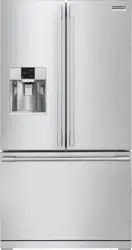Documents: Go to download!
User Manual
- User Manual - (English)
- Owner's Guide - (Spanish)
- Owner's Guide - (French)
- Installation Instructions - (English)
- Energy Guide - (English)
- Specifications - (French)
- FEATURES AT A GLANCE - PRO MODEL
- DOOR REMOVAL INSTRUCTIONS
- INSTALLING DOOR HANDLES
- CONTROLS - FRIGIDAIRE PROFESSIONAL
- STORAGE FEATURES
- STORING FOOD AND SAVING ENERGY
- NORMAL OPERATING SOUNDS AND SIGHTS
- CHANGING THE FILTER
- CARE & CLEANING
- BEFORE YOU CALL
Table of contents
USER MANUALS
FEATURES AT A GLANCE - PRO MODEL
* Features may vary according to model
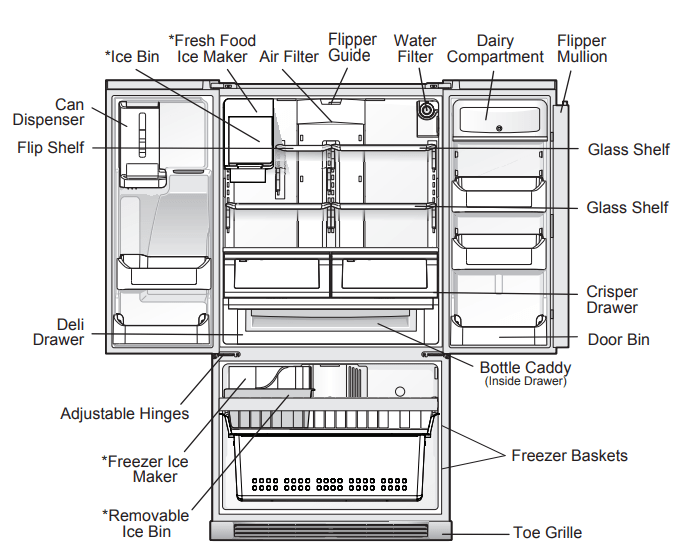
IMPORTANT Features not purchased with your refrigerator can be purchased at www.frigidaire.com or by calling 1-800-944-9044.
DOOR REMOVAL INSTRUCTIONS
Getting through narrow spaces
If your refrigerator will not fit through an entrance area, you can remove the doors. Check first by measuring the entrance.
To prepare for removing the doors:
- Make sure the electrical power cord is unplugged from the wall outlet.
- Open the freezer drawer and remove the toe grille (see Installation section).
- Remove any food from the door shelves and close the doors.
To remove the top hinge covers:
- Remove the two screws from each cover over the top door hinges.
- Lift inside edge of hinge cover and tilt back.
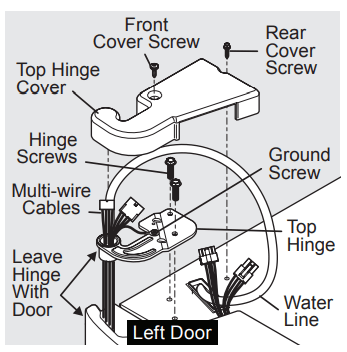

NOTE DO NOT remove the ground screw from hinge.
To remove the refrigerator doors
WARNING Make sure the electrical power cord is unplugged from the wall outlet.
1.Remove top hinge covers. Trace lightly around the door’s top hinges with a pencil. This makes reinstallation easier.

2. Disconnect the harness by grasping both sides of the connector firmly, depress the latch and pull apart.
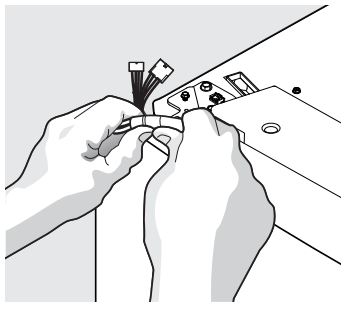
3. Detach the water tube from the connector located behind the refrigerator, the connector releases when you press inward on the connector’s outer sleeve. Pull the water tube out toward the front of the unit.
NOTE You will be pulling approximately five feet of water tube from the back of the refrigerator.
NOTE Use care while pulling the water tube from the unit to be sure that you do not kink the tube.
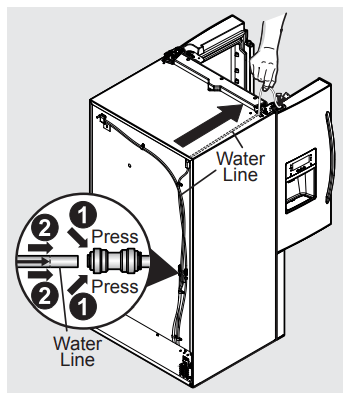
IMPORTANT Open the refrigerator doors to a 90 degree angle before lifting the doors off the bottom hinges and setting them aside.
4. Open the refrigerator doors to a 90 degree angle and remove the two screws from the top hinge. Lift and remove door from lower hinge.
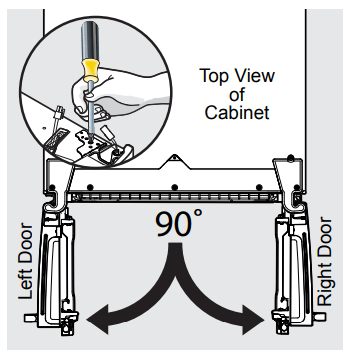
CAUTION Be sure doors are set aside in a secure position where they cannot fall and cause personal injury, or damage to the doors or handles.
5 Unscrew the three lower hinge screws and remove the hinge.

To reinstall the refrigerator doors:
IMPORTANT When replacing the doors on the lower hinge, they must be installed at a 90 degree angle.
1. Replace the lower hinge screws.
2. Holding the door at a 90 degree angle, drop the pin down into the center hinge opening. Rotate it slightly in either direction until the door falls down into place.

3. Reinstall top hinge.
4. Insert the water line in the top left tunnel pushing from the front to the back of the unit.
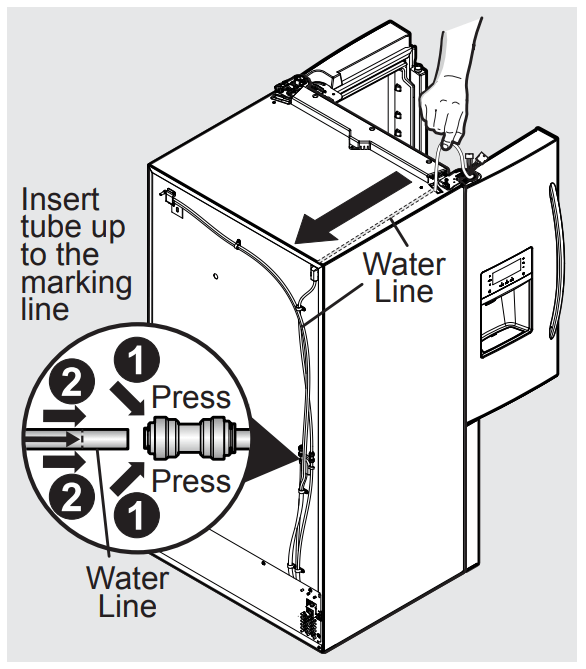
NOTE When reinserting the water tube and replacing the top hinge cover, use care to be sure you do not kink the tube.
NOTE Upon replacement, the tube needs to be fully inserted up to the marking line.
5. Reconnect the harnesses.
6. Replace the top hinge covers.
7. Reconnect electrical power cord to the wall outlet.
To reset door pin:
If doors are removed at less than a 40 degree angle, the pin returns to the home position. It can be reset by turning the door upside and using a 5/32” Allen wrench to rotate the left hand pin 90 degrees clockwise and the right hand pin 90 degrees counterclockwise.
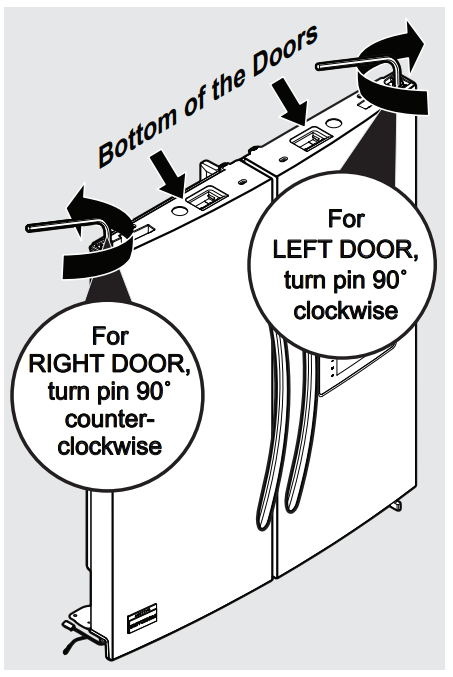
Once the door pins are reset, follow the steps “To reinstall the refrigerator doors”.
Removing Freezer Drawer
CAUTION Drawer is heavy. Use caution when lifting.
- Remove 4 hex head drawer screws.
- Lift up drawer to remove.
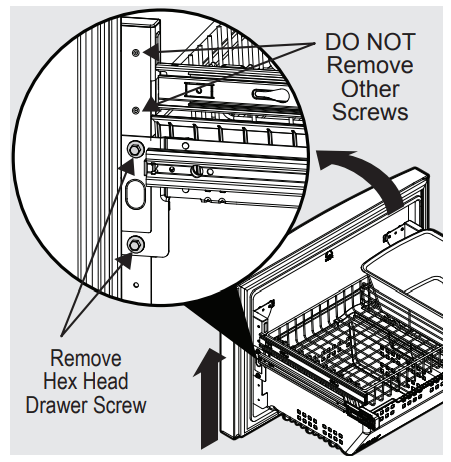
Replacing Freezer Drawer
- Extend the Freezer slides from the unit.
- Carefully align support pin with hooks on end of freezer slides and then lower freezer door onto slides.
- Replace the 4 hex head screws that secure the slides to the door (2 on each side) and tighten.
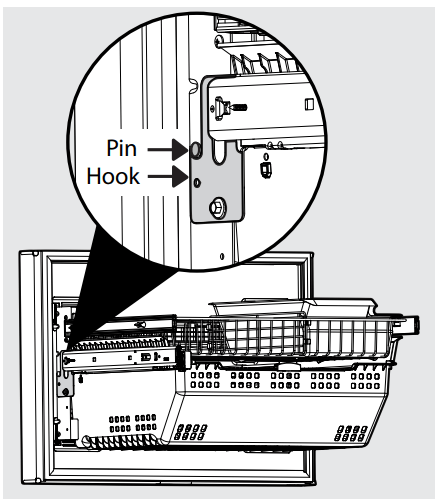
NOTE To locate the pin, look inside the drawer and the pin is next to the door liner and the slides. Not all parts are shown in the illustration.
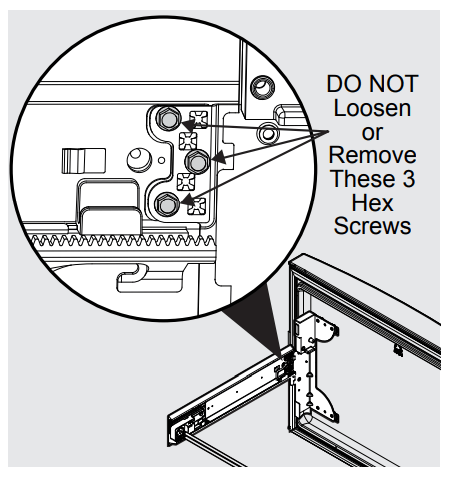
INSTALLING DOOR HANDLES
CAUTION Wear gloves and safety goggles. Use extreme CAUTION when installing these handles.
Door Handle Mounting Instructions for Frigidaire & Frigidaire Gallery
- Remove handles from carton and any other protective packaging.
- Position fresh food handle end caps over upper and lower pre-installed shoulder bolts (A) that are fastened into door, ensuring the holes for the set screws are facing towards the opposite door.
- While holding handle firmly against door, fasten upper and lower Allen set screws (B) with supplied Allen wrench.
- Repeat steps 2 and 3 to install opposite handle. Ensure the holes for the set screws are facing towards the first door.
- Position freezer handle end caps over left and right preinstalled shoulder bolts (A) that are fastened to the door, ensuring the holes for the set screws are facing down.
- While holding handle firmly against door, loosely tighten right Allen set screw (B) with supplied Allen wrench until there is no gap between handle and door.
- Still holding the handle firmly to the door, firmly tighten left Allen set screw (B) with supplied Allen wrench.
- Return to the right Allen set screw (B) and firmly tighten with supplied Allen wrench.
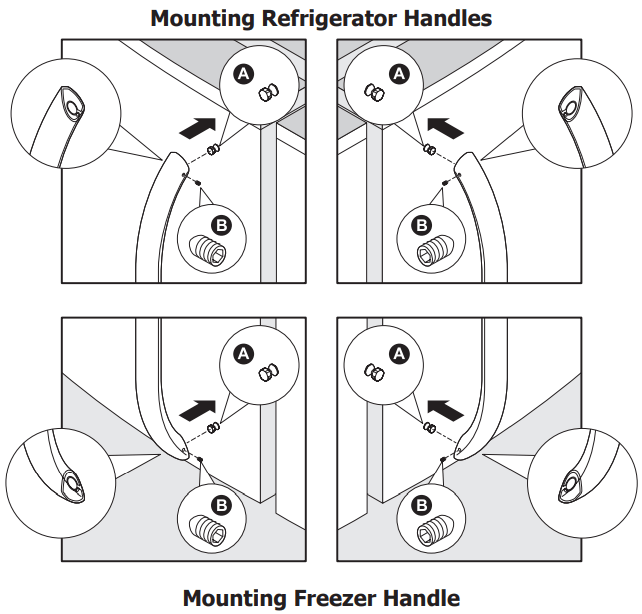
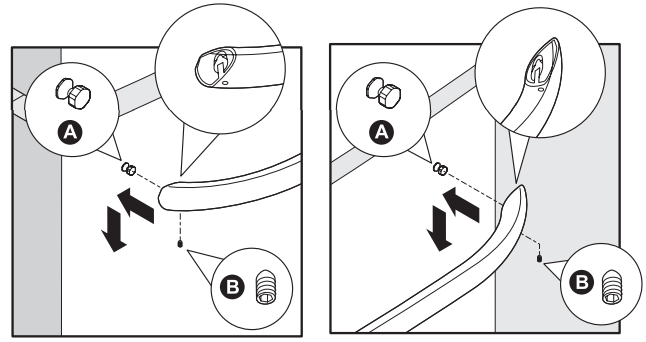
NOTE When tightening the Allen set screws, it is imperative that force be applied to the longer arm of the Allen wrench supplied in the handle packaging.
NOTE All set screws should be tightened so the screw is below the surface of the handle. The handles should be drawn tight to freezer and refrigerator doors with no gaps. Opening the opposite door while tightening the Allen screw makes installation easier. The door handle may loosen over time or if it was installed improperly. If this happens, tighten the set screws on the handles.
CAUTION Wear gloves and safety goggles. Use extreme CAUTION when installing these handles.
Door Handle Mounting Instructions for Frigidaire Professional
- Remove handles from carton and any other protective packaging.
- Position fresh food handle end over upper and lower preinstalled shoulder bolts (A) that are fastened into door, ensuring the holes for the set screws are facing towards the opposite door.
- While holding handle firmly against door, fasten further most upper and further most lower Allen set screws (B) with supplied Allen wrench.
- Repeat steps 2 and 3 to install opposite handle. Ensure the holes for the set screws are facing towards the first door.
- Firmly tighten the inside Allen set screws.
- Position freezer handle end over left and right pre-installed handle shoulder bolts (A) that are fastened to the door, ensuring the holes for the set screws are facing down.
- While holding handle firmly against door, loosely tighten far right Allen set screw (B) with supplied Allen wrench until there is no gap between handle and door.
- Still holding the handle firmly to the door, firmly tighten far left Allen set screw (B) with supplied Allen wrench.
- Return to the far right Allen set screw (B) and firmly tighten with supplied Allen wrench.
- Firmly tighten the inside Allen set screws.
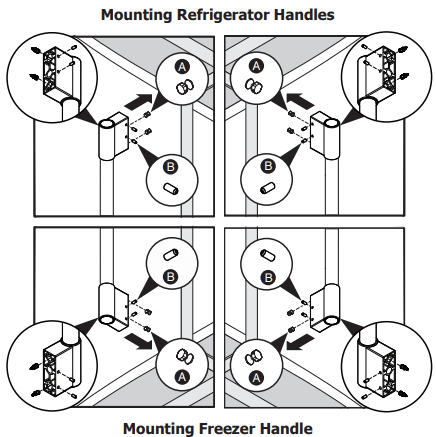
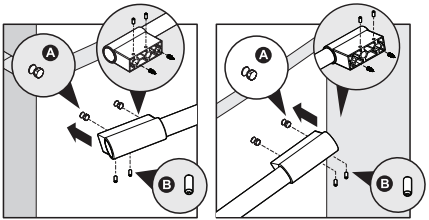
NOTE When tightening the Allen set screws, it is imperative that force be applied to the longer arm of the Allen wrench supplied in the handle packaging.
NOTE All set screws should be tightened so the screw is below the surface of the handle. The handles should be drawn tight to freezer and refrigerator doors with no gaps. Opening the opposite door while tightening the Allen screw makes installation easier. The door handle may loosen over time or if it was installed improperly. If this happens, tighten the set screws on the handles.
CONTROLS - FRIGIDAIRE PROFESSIONAL
User Interface In-Door Controls (options may vary)

| POWER ON-OFF | Press and hold for three seconds to turn off the cooling system. It also turns off the ice maker and all dispenser functions. The display will read “OFF”. |
| DEFAULT SETTINGS | Press and hold for three seconds to reset all refrigerator settings to their factory default settings. |
| ICE MAKER ON-OFF | The Ice Maker is on if the LED above the Icon is illuminated. Ice dispensing will still function. Press and hold the button for 3 seconds to toggle the Ice Maker on and off. |
| POWERPLUS FREEZE | Activates a faster rate for freezing food and increases ice production in the freezer. Deactivates after 12 hours. |
| AIR FILTER | Displays the current status of the air filter (GOOD, ORDER, or REPLACE). To reset the filter status to “GOOD”, press and hold for three seconds. |
| WATER FILTER | Displays the current status of the water filter (GOOD, ORDER, or REPLACE). To reset the filter status to “GOOD”, press and hold for three seconds. |
| MUTE ALARM | Tones emitted by each key press can be turned off based on user preference. The sounds are muted when the red indicator is lit. Warning signals will stay active. |
| REFRIGERATOR TEMP | Allows the temperature setpoints to be adjusted. Press the “-” or “+” indicator to adjust the temperature to the desired setting. Control temperatures range from +33°F / +1°C to +47°F / +8°C. |
| FREEZER TEMP | Allows the temperature setpoints to be adjusted. Press the “-” or “+” indicator to adjust the temperature to the desired setting. Control temperatures range from -6°F / -21°C to +6°F / -15°C. |
| C/F | Toggles display between Clesius and Fahrenheit. |
Dispenser Controls (options may vary)
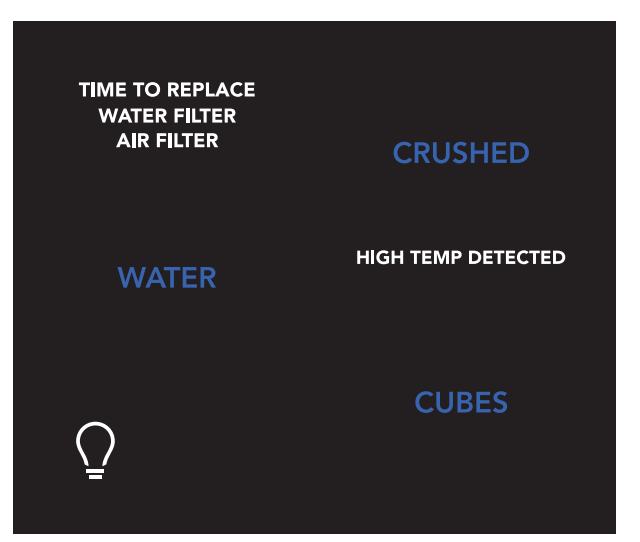
| WATER | Press the “WATER” key to select water. |
| CUBES | Press the “CUBES” key to select cubed ice. |
| CRUSHED | Press the “CRUSHED” key to select crushed ice. |

|
Toggles dispenser light on and off. |
Alarms
Power Failure
In the event of a power failure, the power fail alert will be illuminated. Press “mute alarm” to acknowledge the alarm. Other modes may be turned off until the alarm is acknowledged. While a power failure alert is displayed on the control panel, the unit will continue normal operation. The power fail alert on the control panel will be removed once the user acknowledges the power fail condition by pressing any key on the control panel. The high temp alarm may also be illuminated until a safe operating range temperature has been reached.
Freezer Temp
If the freezer temperature reaches 26°F or greater, the alarm will sound and the temperature will flash and the dispenser control will display “HIGH TEMP DETECTED”. You can disable the alarm by pressing “mute alarm” but the “HIGH TEMP DETECTED” indicator will illuminate until the temperature goes below 26°F.
Fresh Food Temp
If the fresh food temperature reaches 55°F or greater, the alarm will sound and the temperature will flash and the dispenser control will display “HIGH TEMP DETECTED”. You can disable the alarm by pressing “mute alarm” but the “HIGH TEMP DETECTED” indicator will illuminate until the temperature goes below 55°F.
Door Ajar
If the freezer or fresh food doors have been left open for five minutes or more, an alarm will sound and the door ajar indicator will illuminate on the display. Press “mute alarm” to reset any system alarms.
Flapper
When “CUBES” or “CRUSHED” is selected, if the flapper (or ice chute door) is being held open by a jammed ice cube, an alarm will sound for two minutes and the current selection will blink on the dispenser control. The alarm will reset after two minutes or when the ice cube is removed.
Sabbath Mode
The Sabbath Mode is a feature that disables portions of the refrigerator and its controls in accordance with observance of the weekly Sabbath and religious holidays within the Orthodox Jewish community.
Sabbath Mode is turned ON and OFF by simultaneously pressing and holding both the freezer “-” and the refrigerator “+” for five seconds. The display shows “Sb” while in Sabbath mode.
In the Sabbath Mode, the High Temp alarm is active for health reasons. For example, if the door is left ajar the High Temp alarm is activated. The refrigerator will function normally once the door is closed, without any violation of the Sabbath/Holidays. The High Temp alarm is permitted when cabinet temperature is outside the safe zone for 20 minutes. The alarm silences itself after 10 minutes while the High Temp icon stays lit until the Sabbath mode is exited.
For further assistance, guidelines for proper usage and a complete list of models with the Sabbath feature, please visit the web at http:\\www.star-k.org.
NOTE While in Sabbath Mode, neither the lights, dispenser, nor the control panel will work until Sabbath Mode is deactivated. Refrigerator stays in Sabbath Mode after power failure recovery. It must be deactivated with the buttons on the control panel
NOTE Although you have entered the Sabbath Mode, the ice maker will complete the cycle it had already initiated. The ice cube compartment will remain cold and new ice cubes can be made with standard trays.
NOTE During Sabbath Mode, the freezer ice maker will continue to work and must be manually turned off to be compliant with the Sabbath observances.
STORAGE FEATURES
CAUTION To avoid personal injury or property damage, handle tempered glass shelves carefully. Shelves may break suddenly if nicked, scratched, or exposed to sudden temperature change. Allow the glass shelves to stabilize to room temperature before cleaning. Do not wash in dishwasher.
NOTE Features may vary according to model.
You can easily adjust shelf positions in the fresh food compartments to suit your needs. The shelves have mounting brackets that attach to slotted supports at the rear of each compartment.
Change the Position of a Shelf
- Remove all food from shelf.
- Lift the front edge up and pull the shelf out.
- Replace by inserting the mounting bracket hooks into the desired support slots.
- Lower the shelf and lock into position
IMPORTANT Be aware of the air seal located at the rear of the shelf. Shelves located on the left side should have the air seal mounted on the far left side. Shelves located on the right side should have the air seal mounted on the far right side. This is to ensure there is no interference with the large air tower on the back wall of the cabinet. This also applies to the crisper shelves.
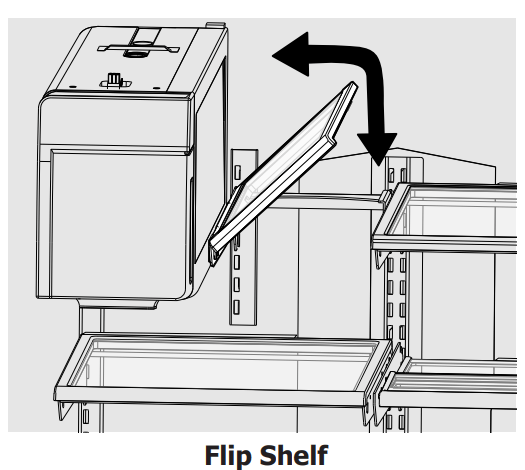
Reposition the Air Seal
For crisper shelves:
- Remove air seal by pushing down on the flap with a downward rotation.
- Position the air seal towards the outside end of the shelf to avoid the air tower when shelf is pushed back into place.
- Install seal by sliding lower tab of seal up into bottom rear slot of shelf with seal at a downward angle then pulling up on seal flap until seal sits snug on back of shelf and flap sits at about a 10 degree angle from shelf surface.
For glass shelves:
- Remove air seal by pushing seal straight back.
- Position the air seal towards the outside edge of the shelf to avoid the air tower when shelf is pushed back into place.
- Install seal by sliding the open channel end of the seal onto back edge of shelf until seal sits snug on back of shelf and flap sits at about a 10 degree angle from shelf surface.
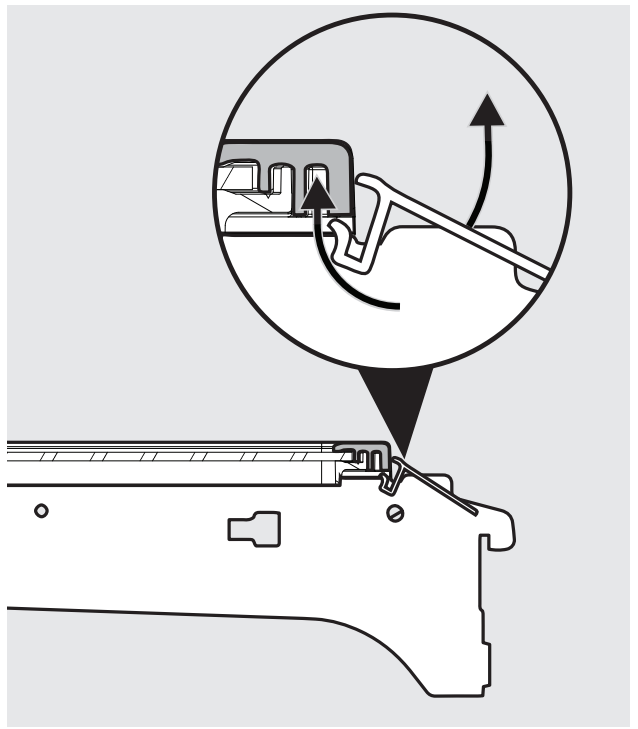
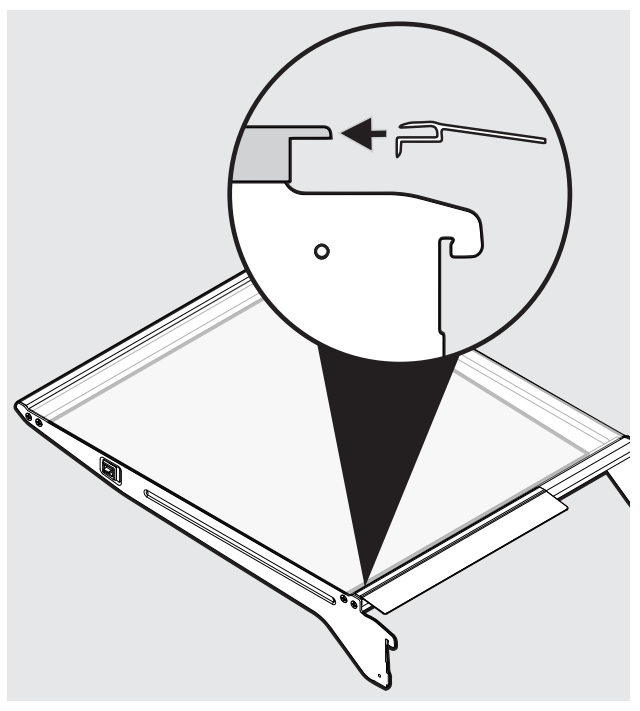
Drawers
Your refrigerator includes a variety of storage drawers.
Crispers
Crisper drawers are designed for storing fruits, vegetables, and other fresh produce.
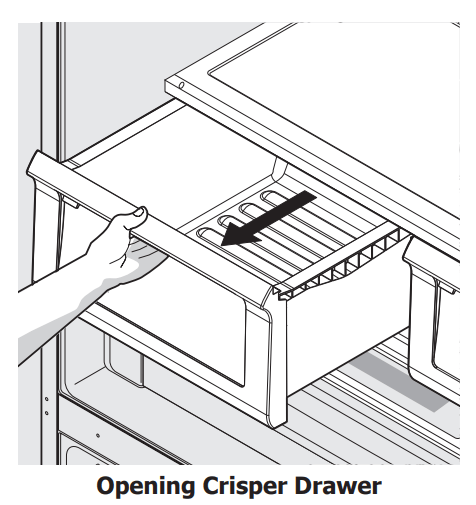
Crisper humidity control
Crisper drawers include a sliding control for adjusting the humidity inside the crisper. Leafy vegetables keep best when stored with the Humidity Control set on Higher Humidity. Fresh fruits keep best when stored with the Humidity Control set on Lower Humidity.
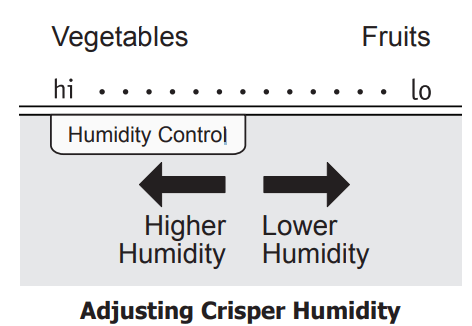
To remove the Crisper Drawer for cleaning:
- Pull the drawer out until it stops.
- Lift the front slightly and remove the drawer.

Deli drawer
Ideal for storage of deli meats, cheese, and beverages.
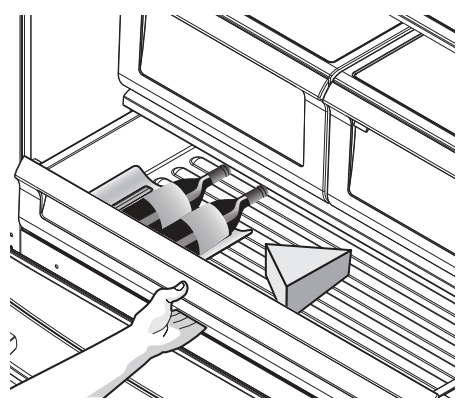
Doors
Storage bins (varies by model)
The doors to your fresh food compartment use a system of modular storage bins. All of these bins are removable for easy cleaning. Some of them have fixed positions, while others can be adjusted to your needs.
Door bins are ideal for storing jars, bottles, cans, and large drink containers. They also enable quick selection of frequently used items.
To change the position of an adjustable door bin:
- Remove all food from door bin.
- Grip the bin firmly with both hands and lift it upward.
- Remove the bin.
- Place the bin just above desired position.
- Lower the bin onto supports until locked in place.
- Place bin liner into bin.
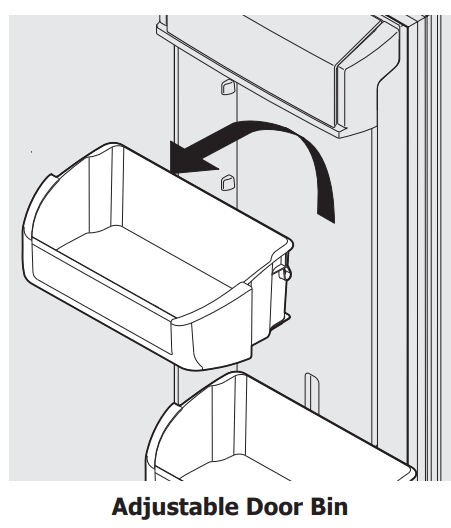
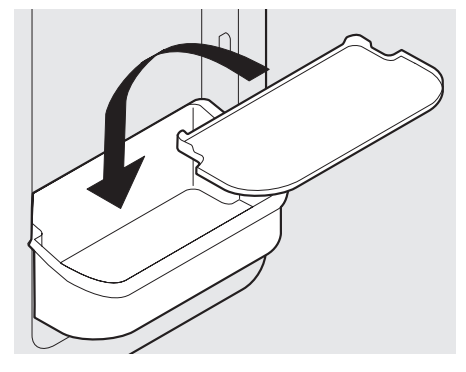
Accessories (varies by model)
Removable Can Dispenser
The can dispenser holds six (12 ounce) cans. Insert cans into top of bin and dispense from the bottom.
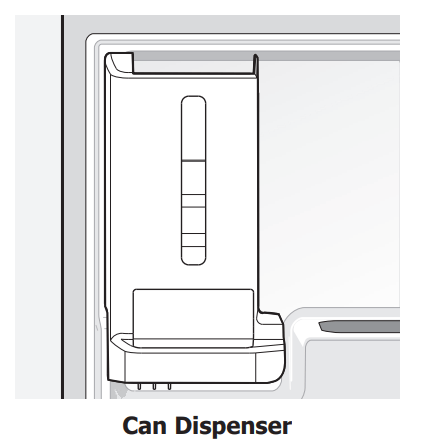
Dairy compartment
Use the dairy compartment, at the top of the fresh food compartment door, for shortterm storage of cheese, spreads, or butter. The dairy compartment is designed to be warmer than the open area and includes a lift-up cover and a dairy divider (select models).
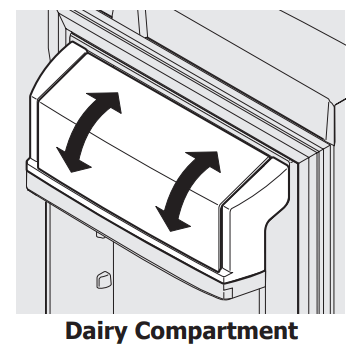
Freezer Features (varies by model)
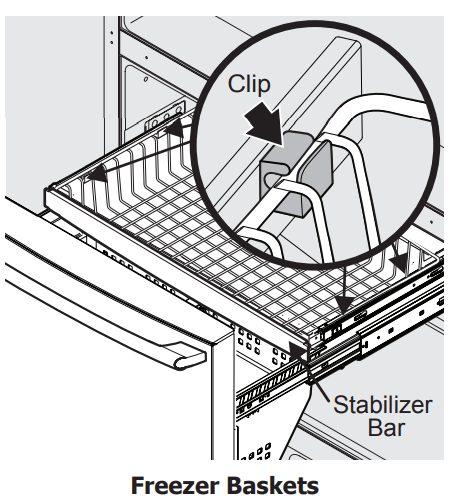
To Remove Upper Freezer Basket
- Find the side where the basket frame is aligned to the clip opening. The basket frame should be aligned to both front and rear clips on the same side (either left or right side).
- If the basket frame is not aligned to the left or right side, push the basket sideways (to either side) until it is aligned.
- By grabbing the basket wire frame close to the frontal clip, pull up to take the basket frame out.
- Grab the basket frame close to the rear clip and pull up until it comes out of the clip.
- Once one side of the basket is off the clips or retainers, slide the basket sideways until the other side of the frame is aligned with the clip openings on the opposite side of the freezer.
- In the same way, pull up the basket frame from the frontal and rear clips until it is out of the clips.
- Remove the basket.
Reverse the steps to reinstall the basket.
NOTE If basket is not resting on stabilizer bar retainer clips, the drawer will not close properly
Removing Freezer Basket Instructions
- Locate the basket clips in the rear corners of the basket and pull them out to remove.
- Open fresh food doors completely.
- Lift the basket up and remove.
Replacing Freezer Basket Instructions
- Place freezer basket back inside the freezer drawer.
- Replace clips by sliding them back into the slots.
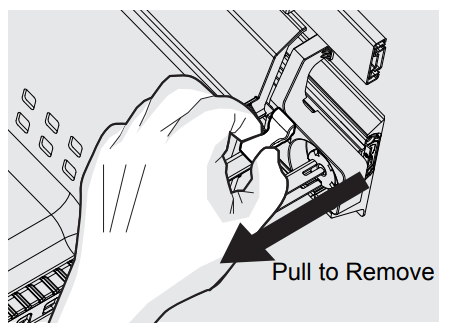
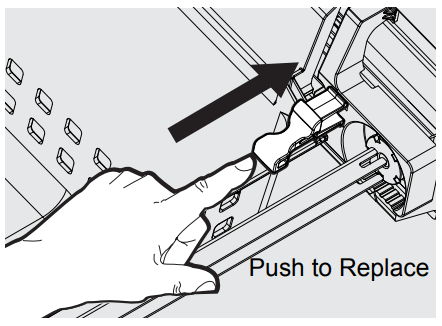
Dividers Removal
Lift up on the front of the upper divider and pull out.
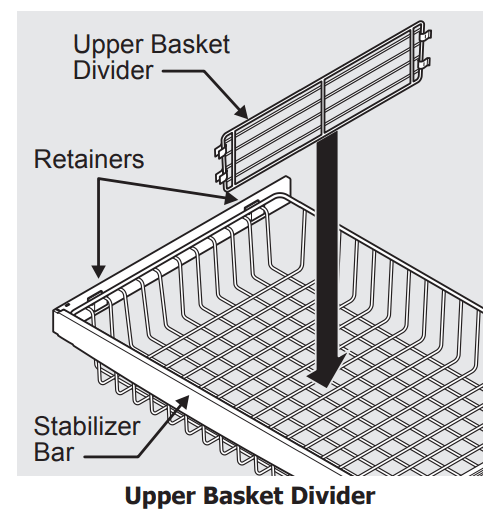
Squeeze handle and lift up in the center of the divider to move it side-to-side. (The divider cannot be removed.)
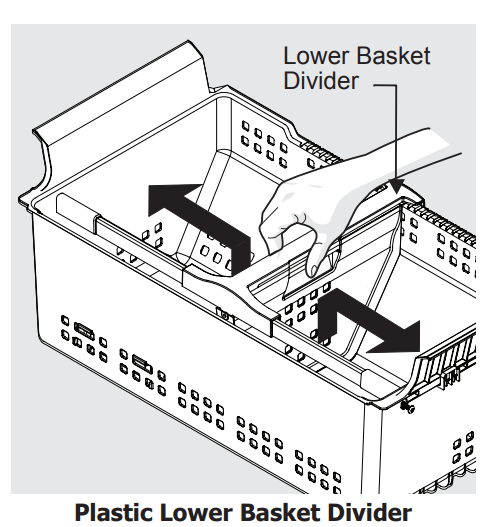
Tilt Wire Shelf
The freezer tilt wire shelf (located on the inside of the freezer drawer) is not designed to be removed.
STORING FOOD AND SAVING ENERGY
Ideas for storing foods
Fresh food storage
- Keep the fresh food compartment between 34°F and 40°F with an optimum temperature of 37°F.
- Avoid overcrowding the refrigerator shelves, which reduces air circulation and causes uneven cooling.
- Avoid placing food in front of air ports. (See Controls Section for illustration.)
Fruits and vegetables
- Store fruits and vegetables in crisper drawers, where trapped moisture helps preserve food quality for longer time periods.
- Wash items and remove excess water.
- Wrap any items that have strong odors or high moisture content.
Meat
- Wrap raw meat and poultry separately and securely to prevent leaks and contamination of other foods or surfaces.
- Use the deli drawer to store meat/poultry for short-term storage. Any meat to be kept longer than two days should be frozen.
Frozen food storage
- Keep the freezer compartment at 0°F or lower.
- A freezer operates most efficiently when it is at least ⅔ full.
Packaging foods for freezing
- To minimize food dehydration and quality deterioration, use aluminum foil, freezer wrap, freezer bags, or airtight containers. Force as much air out of the packages as possible and seal them tightly. Trapped air can cause food to dry out, change color, and develop an off-flavor (freezer burn).
- Wrap fresh meats and poultry with suitable freezer wrap prior to freezing.
- Do not refreeze meat that has completely thawed.
- Prior to grocery shopping, activate “quick freeze” so that on your return you can ensure your newly purchased food designated for the freezer will be preserved as quickly as possible.
- Activating “quick freeze” also will help your freezer more efficiently maintain the selected temperature after placing new purchases with pre-existing frozen foods.
- Avoid adding too much warm food to the freezer at one time. This overloads the freezer, slows the rate of freezing, and can raise the temperature of frozen foods.
- Leave a space between packages, so cold air can circulate freely, allowing food to freeze as quickly as possible.
Ideas for saving energy
Installation
- Locate the refrigerator in the coolest part of the room, out of direct sunlight, and away from heating ducts or registers.
- Do not place the refrigerator next to heat-producing appliances such as a range, oven, or dishwasher. If this is not possible, a section of cabinetry or an added layer of insulation between the two appliances will help the refrigerator operate more efficiently.
- Level the refrigerator so that the doors close tightly.
Temperature settings
- Refer to the “Controls” section for procedures on temperature settings.
Food storage
- Avoid overcrowding the refrigerator or blocking cold air vents. Doing so causes the refrigerator to run longer and use more energy.
- Cover foods and wipe containers dry before placing them in the refrigerator. This cuts down on moisture build-up inside the unit.
- Organize the refrigerator to reduce door openings. Remove as many items as needed at one time and close the door as soon as possible.
- Do not place a hot container directly on a cold shelf. Remember, such an extreme temperature change may damage the glass.
NORMAL OPERATING SOUNDS AND SIGHTS
Understanding the sounds you may hear
Your new, high-efficiency refrigerator may introduce unfamiliar sounds. These sounds normally indicate your refrigerator is operating correctly. Some surfaces on floors, walls, and kitchen cabinets may make these sounds more noticeable.
The following is a list of major components in your refrigerator and the sounds they can cause:
- Evaporator Refrigerant through the evaporator may create a boiling or gurgling sound.
- Evaporator fan You may hear air being forced through the refrigerator by the evaporator fan.
- Defrost heater During defrost cycles, water dripping onto the defrost heater may cause a hissing or sizzling sound. After defrosting, a popping sound may occur.
- Automatic ice maker When ice has been produced, you will hear ice cubes falling into the ice bin. Ice maker fan, water valve activation, and refrigerant gas fluid may create sounds from its operation.
- Electronic control & automatic defrost control These parts can produce a snapping or clicking sound when turning the cooling system on and off.
- Condenser fan You may hear air being forced through the condenser.
- Compressor Modern, high-efficiency compressors run much faster than older models. The compressor may have a highpitched hum or pulsating sound.
- Water valve Makes a buzzing sound each time it opens to fill the ice maker.
- Drain pan (not removable) You may hear water dripping into the drain pan during the defrost cycle. J Condenser May create minimal sounds from forced air.
- Motorized damper May produce a light humming during operation.
- Ice dispensing paddle When dispensing ice, you will hear a snapping, clicking, or popping sound.
NOTE Energy efficient foam in your refrigerator is not a sound insulator.
NOTE During automatic defrost cycle, a red glow in the back wall vents of your freezer compartment is normal.
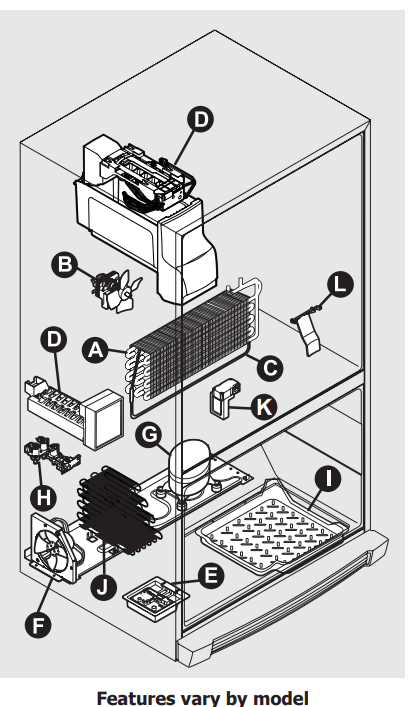
CHANGING THE FILTER
Air filter (Frigidaire Gallery/Professional)
The air filter is located at the top of the air tower.
Replacing your PureAir Ultra IITM air filter
To ensure optimal filtering of refrigerator odors, you should change the air filter every six months (the filter status light on the Touch Panel prompts you to replace the filter after six months).
- Insert fingers in circled area.
- Push clips in to release front cover.
- Remove front cover by pulling towards you and lifting up.
- Replace air filter by sliding into slots.
- Installation of front cover is reverse of removal.
- To reset Air Filter status, refer to instructions under “Controls Section”.
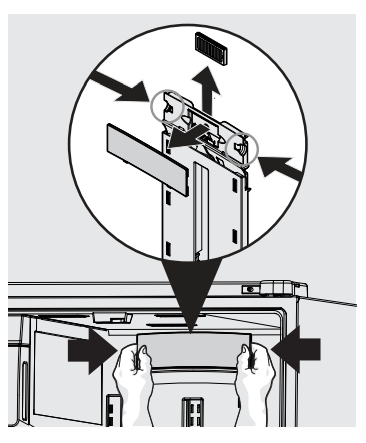
Ordering replacement filters
Order new filters by calling 877-808-4195, online at www.frigidaire.com/store, or through the dealer where you bought your refrigerator. You may want to consider ordering extra filters when you first install your refrigerator. Air Filter Replacement cartridge, part #PAULTRA2
Locating the Filters
Your refrigerator is equipped with water filtering system. The water filter system filters all dispensed drinking water, as well as the water used to produce ice.
Water Filter
The water filter is located at the top right side of the fresh food compartment.
Replacing the Water Filter
In general, you should change the water filter every six months to ensure the highest possible water quality. Water Filter Status on the user interface prompts you to replace the filter after a standard amount of water (125 gallons/473 liters for PureSource Ultra IITM) has flowed through the system.
If your refrigerator has not been used for a period of time (during moving for example), change the filter before reinstalling the refrigerator
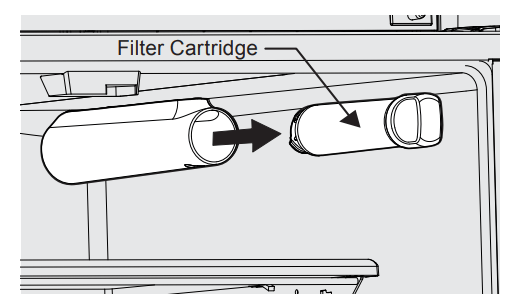
Ordering Replacement Filters
To order your replacement filters, please visit our online store at www.frigidaire.com/store, by calling toll-free at 1-800-599-7569, or by visiting the dealer where you purchased your refrigerator. Frigidaire recommends that you order extra filters when you first install your refrigerator, and that you replace your filters at least once every six months.
Here is the product number to request when ordering:
PureSource Ultra IITM Water Filter Part #EPTWFU01
NOTE When ordering your replacement filter, please reorder the same filter type that is currently in your refrigerator.
More about your Advanced Water Filter
The PureSource Ultra IITM ice and water filter system is tested and certified to NSF/ANSI Standards 43, 53 and 401 for the reduction of claims specified on the performance data sheet.
Do not use with water that is microbiologically unsafe or of unknown quality without adequate disinfection before or after the system. Systems certified for cyst reduction may be used on disinfected waters that may contain filterable cysts
Test & certification results:
- Rated Capacity - 125 gallons/473 liters for PureSource Ultra IITM ice and water filter
- Rated service flow - .65 gallons per minute
- Operating Temp: Min. 33°F, Max. 100°F
- Maximum Rated Pressure - 100 pounds per square inch
- Recommended Minimum Operating Pressure: 30 pounds per square inch
To replace your PureSource Ultra IITM water filter:
It is not necessary to turn the water supply off to change the filter. Be ready to wipe up any small amounts of water released during the filter replacement.
- Turn Off the ice maker power switch.
- Remove the old filter by rotating it counterclockwise (to the left) 90 degrees to release it.
- Slide the old filter cartridge straight out of the housing and discard it.
- Unpackage the new filter cartridge. Slide it into the filter housing as far as it will go with the grip end horizontal.
- Push lightly inward on the filter while rotating it clockwise (to the right). The filter will then pull itself inward as it is rotated. Rotate the filter 90 degrees until it stops and the grip end is vertical. You may be able to feel a very light click as the filter locks into place.
- Press a drinking glass against the water dispenser while checking for any leaks at the filter housing. Any spurts and sputters that occur as the system purges air out of the dispenser system are normal.
- Continue dispensing water for 3-4 minutes or until 1.5 gallons of water has flowed through the system. You will likely need to empty and refill your glass several times.
- Turn On the ice maker.
- Press and hold the Water Filter reset button on the control panel for three seconds. When the display changes from Red to Green, the status has been reset.
CARE & CLEANING
Protecting your investment
Keeping your refrigerator clean maintains its appearance and prevents odor build-up. Wipe up any spills immediately and clean the freezer and fresh food compartments at least twice a year
NOTE Do not use abrasive cleaners such as window sprays, scouring cleansers, flammable fluids, cleaning waxes, concentrated detergents, bleaches, or cleansers containing petroleum products on plastic parts, interior doors, gaskets, or cabinet liners. Do not use paper towels, scouring pads, or other abrasive cleaning materials.
- Never use metallic scouring pads, brushes, abrasive cleaners, or strong alkaline solutions on any surface.
- Never use CHLORIDE or cleaners with bleach to clean stainless steel.
- Do not wash any removable parts in a dishwasher.
- Always unplug the electrical power cord from the wall outlet before cleaning.
NOTE If you set your temperature controls to turn off cooling, power to lights and other electrical components will continue until you unplug the power cord from the wall outlet.
- Remove adhesive labels by hand. Do not use razor blades or other sharp instruments which can scratch the appliance surface.
- Do not remove the serial plate. Removal of your serial plate voids your warranty.
- Before moving your refrigerator, raise the anti-tip brackets so the rollers will work correctly. This will prevent the floor from being damaged.
Refer to the guide on the next page for details on caring and cleaning specific areas of your refrigerator
CAUTION
- Pull the refrigerator straight out to move it. Shifting it from side to side may damage flooring. Be careful not to move the refrigerator beyond the plumbing connections.
- Damp objects stick to cold metal surfaces. Do not touch refrigerated surfaces with wet or damp hands
IMPORTANT If you store or move your refrigerator in freezing temperatures, be sure to completely drain the water supply system. Failure to do so could result in water leaks when the refrigerator is put back into service. Contact a service representative to perform this operation.
Vacation and moving tips
| Occasion | Tips |
| Short Vacations |
|
| Long Vacations |
|
| Moving |
|
Care & Cleaning Tips
| Part | What To Use | Tips and Precautions |
| Interior & Door Liners |
|
Use two tablespoons of baking soda in one quart of warm water. Be sure to wring excess water out of sponge or cloth before cleaning around controls, light bulb or any electrical part. |
| Door Gaskets |
|
Wipe gaskets with a clean soft cloth. |
| Drawers & Bins |
|
Use a soft cloth to clean drawer runners and tracks. |
| Glass Shelves |
|
Allow glass to warm to room temperature before immersing in warm water. |
| Toe Grille |
|
Vacuum dust from front of toe grille. Remove toe grille (see Installation Instructions). Vacuum backside, wipe with sudsy cloth or sponge. Rinse and dry. |
| Exterior & Handles |
|
Do not use commercial household cleaners containing ammonia, bleach or alcohol to clean handles. Use a soft cloth to clean smooth handles. DO NOT use a dry cloth to clean smooth doors. |
| Exterior & Handles (Stainless Steel Models Only) |
|
Never use CHLORIDE or cleaners with bleach to clean stainless steel. Clean stainless steel front and handles with non-abrasive soapy water and a dishcloth. Rinse with clean water and a soft cloth. Use a non-abrasive stainless steel cleaner. These cleaners can be purchased at most home improvement or major department stores. Always follow manufacturer’s instructions. Do not use household cleaners containing ammonia or bleach. NOTE: Always clean, wipe and dry with the grain to prevent scratching. Wash the rest of the cabinet with warm water and mild liquid detergent. Rinse well, and wipe dry with a clean soft cloth. |
BEFORE YOU CALL
1-800-944-9044 (United States)
1-800-265-8352 (Canada)
Visit our web site at www.frigidaire.com
| Concern | Potential Cause | Common Solution |
| Automatic Ice Maker | ||
| Ice maker is not making any ice. |
|
|
| Ice maker is not making enough ice. |
|
|
| Freezer ice maker will not stop making ice (select models). |
|
|
| Ice cubes are freezing together. |
|
|
| Dispenser (Ice & Water) | ||
| Dispenser will not dispense ice. |
|
|
| Ice dispenser is jammed. |
|
|
| Dispenser will not dispense water. |
|
|
| Water not cold enough. |
|
|
| Water has an odd taste and/or odor |
|
|
| Opening/Closing Of Doors/Drawers | ||
| Door(s) will not close. |
|
|
| Drawers are difficult to move. |
|
|
| Running of Refrigerator | ||
| Compressor does not run. |
|
|
| Refrigerator seems to run too much or too long. |
|
|
| Digital Temperature Setting Display | ||
| Digital temperature displays an error. |
|
|
| Water/Moisture/Frost Inside Refrigerator | ||
| Moisture collects on inside of refrigerator walls. |
|
|
| Water collects on bottom side of drawer cover. |
|
|
| Water collects in bottom of drawer. |
|
|
| Water/Moisture/Frost Outside Refrigerator | ||
| Moisture collects on outside of refrigerator or between doors. |
|
|
| Food in Fresh Food Compartment | ||
| Food is freezing. |
|
|
See other models: FPBG2277RF FPBC2277RF FFHN2750TS FFHB2750TS FGHG2368TF
